Text
Quiz 2
Quiz #2
1. FILL IN THE BLANK
To ultimately change behavior: the campaign goal was to increase AWARENESS and ENGAGEMENT, in order to CHANGE BELIEFS, CHANGE PERCEIVED __NORMS__, and therefore change INTENT… established precursors to changing BEHAVIOR.
2. Which research agency handles the external evaluation contract for the This Free Life campaign?
A. ICF
B. RTI
C. Banyan
D. CrossMedia
3. What is the “gold standard” REACH and FREQUENCY goal of a behavior change campaign?
A. 70% of your target audience, 15 times a quarter
B. 70% of your audience, 20 times a quarter
C. 75% of your audience, 15 times a quarter
D. 75% of your audience, 15 times a quarter
4. Define the media metric IMPRESSIONS in 1-2 sentences.
Impressions are the number of times your ad/content was viewed, inclusive of all views/visits, duplicates included.
5. Define the media metric UNIQUE IMPRESSIONS in 1-2 sentences.
Unique impressions are the number of people who viewed/visited your ad/content. So if one person viewed the piece 10 times, that would be one unique impression.
6. Define the marketing term EARNED MEDIA in 1-2 sentences.
Earned media is another way of saying PR. It’s when people start talking about your campaign/product in the public space, independently.
7. Is YouTube an example of a BROAD APPEAL, BUT TARGETED REACH opportunity? (circle or underline one)
T / F
8. The metro station “take over” (advertisements on the station floor, stairs, and walls) described in the lecture occurred in which neighborhood in San Francisco?
The Castro
9. Which app was more effective at reaching members of the LGBT community? (circle one)
GRINDR or OKCUPID.
10. The campaign makes extensive use of influencers. Some of these influencers are YouTube influencers, with their own popular YouTube channels. What format did these YouTube influencers use to create content for the campaign? (circle one)
A. Spoken Word
B. Q & A
C. Reading Mean Tweets
D. Animation
0 notes
Text
PhillyPH v. BostonPH
Forget football y’all, here’s the Philly-Boston square off we’ve all been waiting for: Who’s PH dept is better at the ‘Book?
Before The roast begins, let’s just give some credit where it’s deserved–at least they both have active Facebook pages with at least minimally a few thousand followers. Philly clocks in at 5,165 followers for a city of just over 1.5 mil. Boston fares a little bit better with 5,103 followers for a much smaller city of just over 660K. For some perspective, the National Health Service for the entire COUNTRY of England, with a population of over 54 million people, has under 2 large. Poor NHS really needs some attention :( I can practically taste the desperation, just look at their last post:

“Just, please share. Please. We’ve already lost like 450 million friends this year and we really need some love.” (#brexit)
So, it could be worse guys. #itsallrelative
Let’s start with the Boston Public Health Commission Facebook page. LikeRank: 55
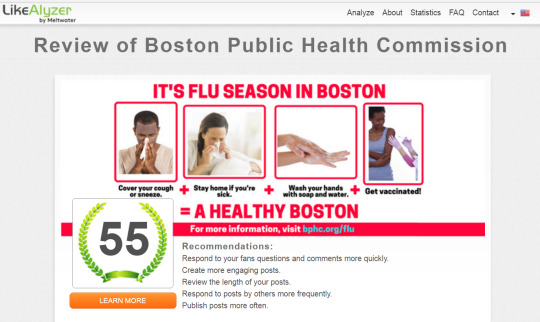
What Boston does well:
The Boston page does a nice job of speaking in a social-media appropriate language: emojis, hashtags, even some abbrevs snuck in there. But it does it in a way that maintains credibility (as in, they don’t sound like my Aunt Mable who just joined Facebook and thinks its still cool to say 2 instead of too and u instead of you *eye roll* this isn’t Xanga circa 2000, Mable). I found this appealing.
They diversify content and voice: A health department’s social media account has the difficult task of appealing to a broad and diverse audience with authentic content. Boston, I think, does a nice job of diversifying it’s voice and the type of content it posts–it switches it up between photo, link, and text posts. I think this is helpful in appealing to a diverse audience that have differing preferences when it comes to what kind of content they want to see.
They post original content. We’ll get to Philly a little later on, which posts next to zero original content–in comparison, Boston posts a lot of original content. Infographics, posters, photos, all of which drive people to BPHC rather than away from it (to other pages, organizations, etc.) I think this helps bolster the BPHC brand, and establishes it as a trusted source for content rather than just a purveyor of it.
What Boston does less well:
Using hashtags: OK, so it’s not that they don’t use hashtags–they do, a lot of them–but that they don’t always use them in an appropriate way. More than just being the socially-acceptable way to talk on social media, hashtags are a helpful way to expand your audience by connecting your post to a broader group of people who are looking at similar posts. But from a public health perspective, hashtags that are too general, or reach the wrong audience, are not going to help you connect with who you want to connect with. As an example, BPHC posted the following using the hashtag #WeCanHelp
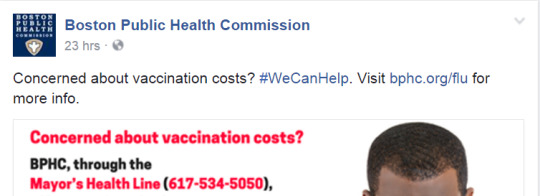
You can help? Great, according to Facebook so can Texas Tower Passport and Visa Services, Roses Restaurant and Bakery Sherwood (OR), and WhizBang! Training. Point being, the hashtag #WeCanHelp is so widely used by geographically, topically, and demographically disparate users that it’s not going to help broaden your audience within the public health community or the Boston community. There are several examples of hashtags like this on the Boston page. Though it’s important to note that BPHC does also use more appropriate hashtags like #rethinkyourdrink and #oralhealthoverallhealth
Next: Toooooo many awareness months. According to BPHC, September is supposedly Sepsis Awareness Month, Rabies Awareness Month, Recovery Awareness month, Infant Mortality Awareness Month, National Preparedness Month, and National Rollerskate Collision Awareness Month. And I only made one of those up.
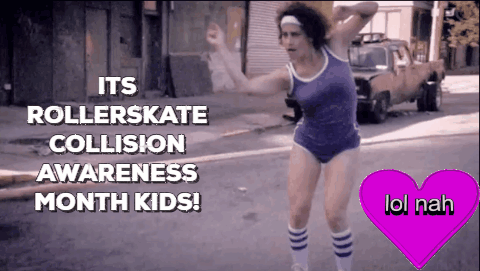
(National Rollerskate Collision Awareness Month although interestingly enough, rollerskate collisions is a real medical condition recognized by the new ICD-10 diagnosis coda, along with being sucked into a jet engine, subsequent encounter, and Burn due to water-skis on fire<–I can totally relate to this one. Don’t ask.) The whole point of an awareness month is to make a concentrated effort to focus on and raise awareness about a specific cause–it’s an all hands on deck, let’s all rally around one particular issue. You defeat the purpose and dilute interest when you post about 5 different awareness months in the same month.
Last but not least, relatedly, the page posts about too many campaigns without following through on most of them. The page launched a campaign about preparedness, saying they’d post daily about tips to help you stay safe…but then the next two posts are about HIV and rabies from unrelated campaigns? It makes for a muddled message, and the end result is that while there’s a TON of great information on there, none of the campaigns really gain enough momentum to warrant following and further engaging with them.
Moving on: The Philadelphia Department of Public Health Facebook page. LikeRank: 53, about on par with Boston.
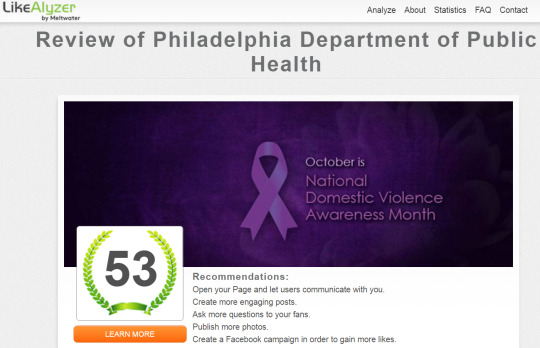
We’ll start again with what they do well:
They leverage VIPs to bolster interest: People like to fangirl over celebs, and are more likely to be interested in boring stuff like prostate cancer (v. important, but still boring to most) when Ben Stiller tells you to, or heart disease when Queen Latifah tells you to be. And we’re definitely more likely to be interested in childhood obesity when our other Queen, Michelle Obama, tells us to be. And in fact, the post about Queen Latifah was the second most liked post on the page in the last few weeks (with a whopping 9 likes. Michelle got 13 a while back. The real question is who are these other monsters NOT liking Michelle Obama…). They could take this further and even get influencers to post on their behalf/link to their page.
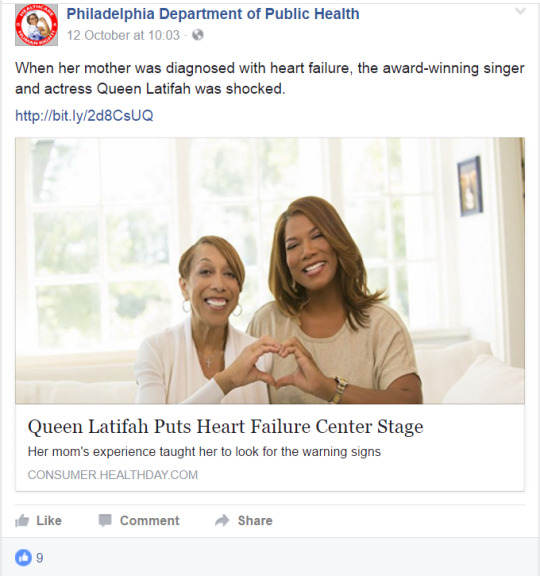
They post Philly specific stuff: Philly is a great city! Full of awesome stuff, let’s celebrate and share the fun, healthy stuff happening in this city while also talking about other important, national, public health stuff! The page often shares posts about cool cultural events happening in the city, about great public spaces around town to enjoy actively or socially, tips from local experts, and awards or recognition the city has received. I think this is a great way to boost engagement and position the BPHD brand as a trusted source not just for public health info, but also for philly pride/local happenings. It also enhances relevance (important to facilitating central processing of information). Reading an article about the health benefits of exercise is one thing, but being told about a cool local event that just *happens* to involve exercise is another—its a less conspicuous, more practical way of not just getting a message across, but actually facilitating action.
Civic Literacy/Civic Engagement: The BPHC facebook page does a great job of encouraging civic engagement on issues important to public health in the community. For example, they regularly post about how to register to vote and upcoming voter registration deadlines, as well as information about proposed bills that have implications for public health in the philly community. Beyond that, they also occasionally post in a way that situates public health issues in a civic perspective. See below on connecting tobacco marketing to poverty. I think this is a really great way to appeal to the justice-seeking side of their followers in addition to the health-seeking.
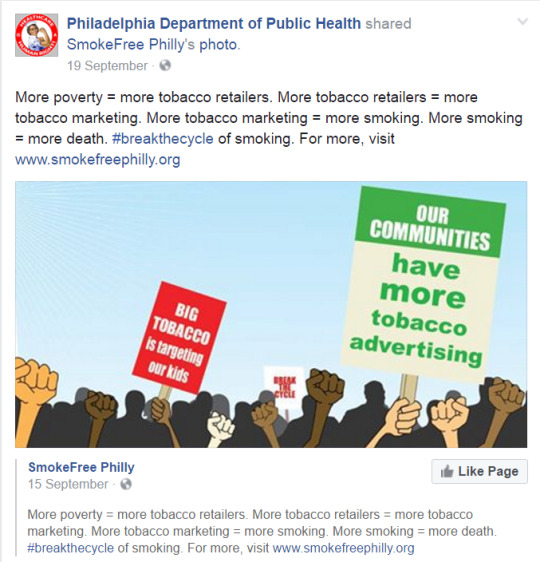
#downwithbigtobacco #sooverit
Now, onto what they don’t do so well:
No original content: They don’t really post any of their own content–everything they post is linking to external sources and organizations. The implication of this is that they are not positioning themselves, the Philadelphia Public Health Department, as a source for quality, original public health content and information. Rather, they’re just someone that posts a lot of informative links. Further, they drive traffic away from them as opposed to back to them. Not good for establishing and growing their brand. This may be in part why their likes growth rate (.058%) is abysmal.
No shareable/likeable content: So, this sounds harsh, and I don’t mean to say they’re not posting interesting or important content, it’s just that they’re not (at least not regularly) posting content in a manner that encourages sharing and engagement. You know, great to let folks know that it’s National Depression Screening Awareness Day, but what about letting them know how important it is to share this information with their friends and family? Better yet, what about posting something, idk, FUNNY or entertaining in some way that someone might want to share? A meme? a gif?
They don’t respond to their followers: This one is just unacceptable. Ok so buckle up and listen to this…back in September, BPHD posted an article about the issue of corporal punishment/child abuse, with a caption directly asking “You’re in the supermarket and you see a parent hit their child. What do you do?” DAMN, good question, what would I do??! Ok, so THEN, one of their followers ACTUALLY RESPONDS (this is unheard of y’all, at least for the BPHD facebook page):
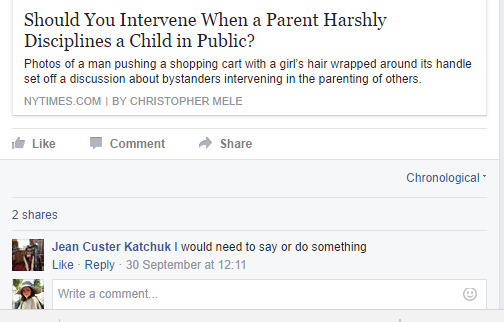
………………………………………………
………………………………………………………..
……………………………………………………………………
……………………………………………………………………………..
………………………………………………………………………………………..
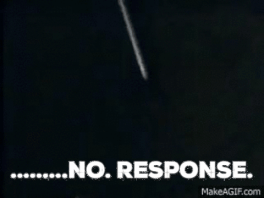
They GHOSTED Jean. Girl I have been there. Poor Jean is still waiting for a text back a month later, wondering if she said something stupid or put herself out there too much or misread the question or was too forward or……..wait I’m projecting. But you get the point–you finally got someone to engage and then you don’t validate that engagement with a response? What was the ducking (*iphone autocorrect) point in asking a question to begin with, then? No wonder your users aren’t engaging with you, it’s like talking to a brick (facebook) wall.
Jean—I just want to say that, I hear you, and me too.
All in all, I want to first emphasize that I think both Boston and Philly do a really wonderful job leveraging Facebook to reach their audience, and everything in this post is meant to be in good fun, and as an academic exercise/practice in analyzing social media use in public health. Next, I want to make the point that I don’t think public health should be as afraid of having a personality on social media. I feel like we are just seen as, like, the narcs everywhere we go….and it doesn’t have to be like that!
We can change what it means to be a cool mom. *mic drop*

@globalcommunicationproject
1 note
·
View note
Text
Give 1000% in your baby’s first 1000 days
The GIFs in this post were created on behalf of the first 1000 days UNICEF campaign and @globalcommunicationproject to promote neuro-development in early childhood. Children need proper nutrition, stimulation, and protection in the first 1000 days of life in order to thrive and develop appropriately. There are many exciting milestones that happen in a child’s brain development in the first 1000 days of life if a child is given the proper care. These GIFs each represent one of these important milestones, and each milestone is geared particularly towards a particular parental persona. These parental personas are informed by research done by the University of Virginia Institute for Advanced Studies in Culture, which surveyed American families to better understand the key values informing parenting style.
Faithful parents center their role as parents around morality--these parents care about their children understanding right from wrong. The child in this GIF is nodding emphatically, a gesture symbolic of acknowledging something is right.
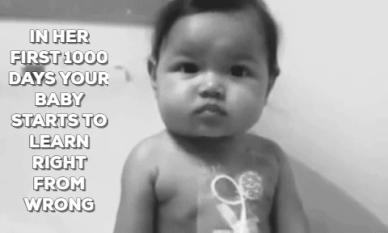
Engaged progressive parents value independence and personal freedom--these parents care about their children being able to explore and question the world around them. The child in this GIF is gleefully crawling around outside, exploring the world around her.
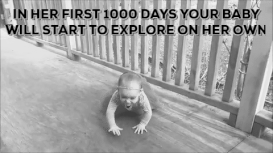
Detached parents view honesty as the core guiding principle in their families--these parents care about their children understanding the importance of the truth. The child in this GIF is playing peek-a-boo, a common game children play during which they begin to distinguish truth from falsehood.
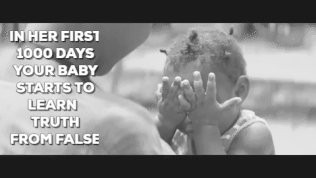
Each GIF seeks to embody elements of these three values--morality, independence, and honesty--as key developmental milestones in a child’s first 1000 days, and aims to speak to each parental persona’s sense of obligation to help their children achieve these milestones. The GIFs will be presented, as a part of a broader campaign targeting expectant mothers, along with a call to action to learn more about how to help children in their first 1000 days with proper nutrition, stimulation, and protection.
0 notes